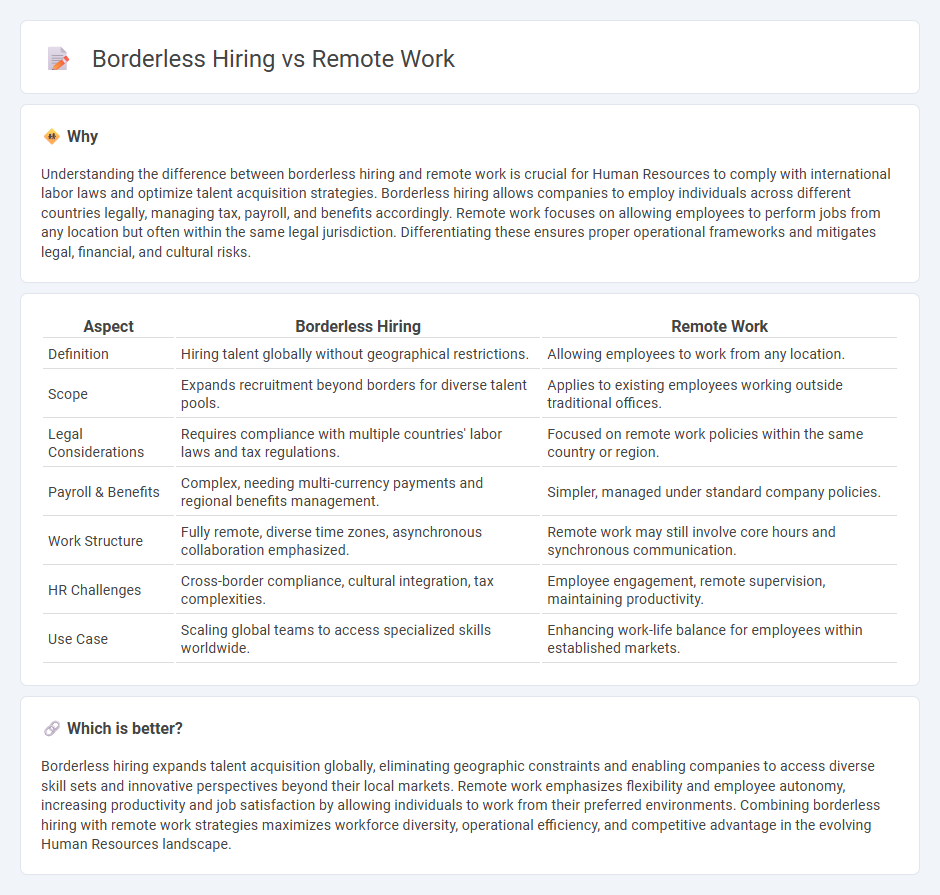
Borderless hiring eliminates geographical restrictions, enabling companies to access global talent pools without the need for employee relocation. Remote work focuses on enabling employees to perform their duties from various locations, often within existing organizational boundaries. Explore the differences between borderless hiring and remote work to optimize your HR strategies.
Why it is important
Understanding the difference between borderless hiring and remote work is crucial for Human Resources to comply with international labor laws and optimize talent acquisition strategies. Borderless hiring allows companies to employ individuals across different countries legally, managing tax, payroll, and benefits accordingly. Remote work focuses on allowing employees to perform jobs from any location but often within the same legal jurisdiction. Differentiating these ensures proper operational frameworks and mitigates legal, financial, and cultural risks.
Comparison Table
| Aspect | Borderless Hiring | Remote Work |
|---|---|---|
| Definition | Hiring talent globally without geographical restrictions. | Allowing employees to work from any location. |
| Scope | Expands recruitment beyond borders for diverse talent pools. | Applies to existing employees working outside traditional offices. |
| Legal Considerations | Requires compliance with multiple countries' labor laws and tax regulations. | Focused on remote work policies within the same country or region. |
| Payroll & Benefits | Complex, needing multi-currency payments and regional benefits management. | Simpler, managed under standard company policies. |
| Work Structure | Fully remote, diverse time zones, asynchronous collaboration emphasized. | Remote work may still involve core hours and synchronous communication. |
| HR Challenges | Cross-border compliance, cultural integration, tax complexities. | Employee engagement, remote supervision, maintaining productivity. |
| Use Case | Scaling global teams to access specialized skills worldwide. | Enhancing work-life balance for employees within established markets. |
Which is better?
Borderless hiring expands talent acquisition globally, eliminating geographic constraints and enabling companies to access diverse skill sets and innovative perspectives beyond their local markets. Remote work emphasizes flexibility and employee autonomy, increasing productivity and job satisfaction by allowing individuals to work from their preferred environments. Combining borderless hiring with remote work strategies maximizes workforce diversity, operational efficiency, and competitive advantage in the evolving Human Resources landscape.
Connection
Borderless hiring expands talent acquisition by removing geographical constraints, enabling companies to access diverse skill sets worldwide. Remote work technologies facilitate this approach by allowing seamless collaboration and communication across time zones. Together, they optimize workforce flexibility, increase productivity, and reduce operational costs.
Key Terms
Telecommuting
Telecommuting enables employees to work remotely from any location, offering flexibility and reducing commuting time without geographical constraints. Unlike remote work, borderless hiring specifically targets acquiring talent globally, emphasizing cross-border recruitment and compliance with international labor laws. Explore the benefits and challenges of telecommuting within global hiring strategies to enhance workforce efficiency and diversity.
Global Talent Acquisition
Remote work unlocks access to skilled professionals regardless of location, enabling companies to tap into global talent pools without geographic constraints. Borderless hiring expands this by simplifying compliance with international labor laws, payroll, and benefits, ensuring seamless integration of employees worldwide. Discover how embracing these strategies transforms global talent acquisition for competitive advantage.
Compliance
Remote work compliance involves adhering to labor laws, tax regulations, and data privacy standards within the employee's jurisdiction, ensuring legal operation without risking penalties. Borderless hiring expands compliance challenges by requiring multinational legal expertise, handling cross-border payroll, benefits administration, and work authorization complexities. Explore comprehensive strategies to navigate evolving compliance demands in remote and borderless work environments.
Source and External Links
What Is Remote Work? Ultimate Guide - Remote work refers to a professional setting where employees work from locations outside the company's physical office, such as home, coffee shops, or while traveling, enabled by digital tools like Slack and Zoom.
What is the definition of remote work? - Remote work is defined as a flexible arrangement under a written agreement where employees perform duties at an alternative worksite and do not regularly work at the agency's main site.
Remote Work: Jobs, Companies & Virtual Teams - Remote.co - Remote.co provides access to thousands of remote and hybrid jobs globally, allowing workers to find flexible, work-from-home roles across many industries.
 dowidth.com
dowidth.com